Design of Transparent Metasurfaces Based on Asymmetric Nanostructures for Directional and Selective Absorption
Abstract
:1. Introduction
2. Materials and Methods
3. Results and Discussion
4. Conclusions
Supplementary Materials
Author Contributions
Funding
Conflicts of Interest
References
- Traverse, C.J.; Pandey, R.; Barr, M.C.; Lunt, R.R. Emergence of highly transparent photovoltaics for distributed applications. Nat. Energy 2017, 2, 849–860. [Google Scholar] [CrossRef]
- Jonsson, G.; Tordera, D.; Pakizeh, T.; Jaysankar, M.; Miljkovic, V.; Tong, L.; Jonsson, M.P.; Dmitriev, A. Solar Transparent Radiators by Optical Nanoantennas. Nano Lett. 2017, 17, 6766–6772. [Google Scholar] [CrossRef] [PubMed] [Green Version]
- Li, X.H.; Liu, C.; Feng, S.P.; Fang, N.X.L. Broadband Light Management with Thermochromic Hydrogel Microparticles for Smart Windows. Joule 2019, 3, 290–302. [Google Scholar] [CrossRef] [Green Version]
- Liu, D.; Li, Q. Sub-nanometer planar solar absorber. Nano Energy 2017, 34, 172–180. [Google Scholar] [CrossRef]
- Dong, W.L.; Cao, T.; Liu, K.; Simpson, R.E. Flexible omnidirectional and polarisation-insensitive broadband plasmon-enhanced absorber. Nano Energy 2018, 54, 272–279. [Google Scholar] [CrossRef]
- Shi, Y.; Li, R.Y.; Jin, Y.; Zhuo, S.F.; Shi, L.; Chang, J.; Hong, S.; Ng, K.C.; Wang, P. A 3D Photothermal Structure toward Improved Energy Efficiency in Solar Steam Generation. Joule 2018, 2, 1171–1186. [Google Scholar] [CrossRef]
- Shen, Y.C.; Hsu, C.W.; Yeng, Y.X.; Joannopoulos, J.D.; Soljacic, M. Broadband angular selectivity of light at the nanoscale: Progress, applications, and outlook. Appl. Phys. Rev. 2016, 3, 011103. [Google Scholar] [CrossRef] [Green Version]
- Khodasevych, I.E.; Wang, L.P.; Mitchell, A.; Rosengarten, G. Micro- and Nanostructured Surfaces for Selective Solar Absorption. Adv. Opt. Mater. 2015, 3, 852–881. [Google Scholar] [CrossRef]
- Ng, C.; Yap, L.W.; Roberts, A.; Cheng, W.; Gómez, D.E. Black Gold: Broadband, High Absorption of Visible Light for Photochemical Systems. Adv. Funct Mater. 2017, 27, 1604048. [Google Scholar] [CrossRef]
- Li, W.; Guler, U.; Kinsey, N.; Naik, G.V.; Boltasseva, A.; Guan, J.; Shalaev, V.M.; Kildishev, A.V. Refractory plasmonics with titanium nitride: Broadband metamaterial absorber. Adv. Mater. 2014, 26, 7959–7965. [Google Scholar] [CrossRef]
- Ghobadi, A.; Hajian, H.; Butun, B.; Ozbay, E. Strong Light-Matter Interaction in Lithography-Free Planar Metamaterial Perfect Absorbers. ACS Photonics 2018, 5, 4203–4221. [Google Scholar] [CrossRef] [Green Version]
- Mitridis, E.; Schutzius, T.M.; Sicher, A.; Hail, C.U.; Eghlidi, H.; Poulikakos, D. Metasurfaces Leveraging Solar Energy for Icephobicity. ACS Nano 2018, 12, 7009–7017. [Google Scholar] [CrossRef] [PubMed] [Green Version]
- Zhou, L.; Tan, Y.L.; Wang, J.Y.; Xu, W.C.; Yuan, Y.; Cai, W.S.; Zhu, S.N.; Zhu, J. 3D self-assembly of aluminium nanoparticles for plasmon-enhanced solar desalination. Nat. Photonics 2016, 10, 393–398. [Google Scholar] [CrossRef]
- Lin, H.; Sturmberg, B.C.P.; Lin, K.-T.; Yang, Y.; Zheng, X.; Chong, T.K.; de Sterke, C.M.; Jia, B. A 90-nm-thick graphene metamaterial for strong and extremely broadband absorption of unpolarized light. Nat. Photonics 2019, 13, 270–276. [Google Scholar] [CrossRef]
- Chang, C.C.; Kort-Kamp, W.J.M.; Nogan, J.; Luk, T.S.; Azad, A.K.; Taylor, A.J.; Dalvit, D.A.R.; Sykora, M.; Chen, H.T. High-Temperature Refractory Metasurfaces for Solar Thermophotovoltaic Energy Harvesting. Nano Lett. 2018, 18, 7665–7673. [Google Scholar] [CrossRef] [PubMed]
- Guo, C.F.; Sun, T.Y.; Cao, F.; Liu, Q.; Ren, Z.F. Metallic nanostructures for light trapping in energy-harvesting devices. Light Sci. Appl. 2014, 3, e161. [Google Scholar]
- Zhou, L.; Tan, Y.; Ji, D.; Zhu, B.; Zhang, P.; Xu, J.; Gan, Q.; Yu, Z.; Zhu, J. Self-assembly of highly efficient, broadband plasmonic absorbers for solar steam generation. Sci. Adv. 2016, 2, e1501227. [Google Scholar] [CrossRef] [Green Version]
- Ma, C.; Yan, J.; Huang, Y.; Wang, C.; Yang, G. The optical duality of tellurium nanoparticles for broadband solar energy harvesting and efficient photothermal conversion. Sci. Adv. 2018, 4, eaas9894. [Google Scholar] [CrossRef] [Green Version]
- Riley, C.T.; Smalley, J.S.; Brodie, J.R.; Fainman, Y.; Sirbuly, D.J.; Liu, Z. Near-perfect broadband absorption from hyperbolic metamaterial nanoparticles. Proc. Natl. Acad. Sci. USA 2017, 114, 1264–1268. [Google Scholar] [CrossRef] [Green Version]
- Devlin, R.C.; Khorasaninejad, M.; Chen, W.T.; Oh, J.; Capasso, F. Broadband high-efficiency dielectric metasurfaces for the visible spectrum. Proc. Natl. Acad. Sci. USA 2016, 113, 10473–10478. [Google Scholar] [CrossRef] [Green Version]
- Wu, D.; Liu, C.; Liu, Y.; Yu, L.; Yu, Z.; Chen, L.; Ma, R.; Ye, H. Numerical study of an ultra-broadband near-perfect solar absorber in the visible and near-infrared region. Opt. Lett. 2017, 42, 450–453. [Google Scholar] [CrossRef] [PubMed]
- Fang, J.; Liu, Q.L.; Zhang, W.; Gu, J.J.; Su, Y.S.; Su, H.L.; Guo, C.P.; Zhang, D. Ag/diatomite for highly efficient solar vapor generation under one-sun irradiation. J. Mater. Chem. A 2017, 5, 17817–17821. [Google Scholar] [CrossRef]
- Zhou, X.Y.; Zhao, F.; Guo, Y.H.; Zhang, Y.; Yu, G.H. A hydrogel-based antifouling solar evaporator for highly efficient water desalination. Energy Environ. Sci. 2018, 11, 1985–1992. [Google Scholar] [CrossRef]
- Huang, Y.; Pu, M.; Gao, P.; Zhao, Z.; Li, X.; Ma, X.; Luo, X. Ultra-broadband large-scale infrared perfect absorber with optical transparency. Appl. Phys. Express 2017, 10, 112601. [Google Scholar] [CrossRef]
- ElKabbash, M.; Iram, S.; Letsou, T.; Hinczewski, M.; Strangi, G. Designer Perfect Light Absorption Using Ultrathin Lossless Dielectrics on Absorptive Substrates. Adv. Opt. Mater. 2018, 6, 1800672. [Google Scholar] [CrossRef]
- Chirumamilla, M.; Chirumamilla, A.; Yang, Y.Q.; Roberts, A.S.; Kristensen, P.K.; Chaudhuri, K.; Boltasseva, A.; Sutherland, D.S.; Bozhevolnyi, S.I.; Pedersen, K. Large-Area Ultrabroadband Absorber for Solar Thermophotovoltaics Based on 3D Titanium Nitride Nanopillars. Adv. Opt. Mater. 2017, 5, 1700552. [Google Scholar] [CrossRef]
- Geldmeier, J.; König, T.; Mahmoud, M.A.; El-Sayed, M.A.; Tsukruk, V.V. Tailoring the Plasmonic Modes of a Grating-Nanocube Assembly to Achieve Broadband Absorption in the Visible Spectrum. Adv. Funct. Mater. 2014, 24, 6797–6805. [Google Scholar] [CrossRef]
- Molet, P.; Garcia-Pomar, J.L.; Matricardi, C.; Garriga, M.; Alonso, M.I.; Mihi, A. Ultrathin Semiconductor Superabsorbers from the Visible to the Near-Infrared. Adv. Mater. 2018, 30, 1705876. [Google Scholar] [CrossRef]
- Shrestha, S.; Wang, Y.; Overvig, A.C.; Lu, M.; Stein, A.; Negro, L.D.; Yu, N. Indium Tin Oxide Broadband Metasurface Absorber. ACS Photonics 2018, 5, 3526–3533. [Google Scholar] [CrossRef]
- Shi, Q.; Connell, T.U.; Xiao, Q.; Chesman, A.S.R.; Cheng, W.; Roberts, A.; Davis, T.J.; Gómez, D.E. Plasmene Metasurface Absorbers: Electromagnetic Hot Spots and Hot Carriers. ACS Photonics 2019, 6, 314–321. [Google Scholar] [CrossRef]
- Ryu, Y.; Kim, C.; Ahn, J.; Urbas, A.M.; Park, W.; Kim, K. Material-Versatile Ultrabroadband Light Absorber with Self-Aggregated Multiscale Funnel Structures. ACS Appl. Mater. Interfaces 2018, 10, 29884–29892. [Google Scholar] [CrossRef] [PubMed]
- Wu, D.; Liu, Y.; Xu, Z.; Yu, Z.; Yu, L.; Chen, L.; Liu, C.; Li, R.; Ma, R.; Zhang, J.; et al. Numerical Study of the Wide-angle Polarization-Independent Ultra-Broadband Efficient Selective Solar Absorber in the Entire Solar Spectrum. Solar RRL 2017, 1, 1700049. [Google Scholar] [CrossRef]
- Walker, C.; Mitridis, E.; Kreiner, T.; Eghlidi, H.; Schutzius, T.M.; Poulikakos, D. Transparent Metasurfaces Counteracting Fogging by Harnessing Sunlight. Nano Lett. 2019, 19, 1595–1604. [Google Scholar] [CrossRef] [PubMed] [Green Version]
- Tordera, D.; Zhao, D.; Volkov, A.V.; Crispin, X.; Jonsson, M.P. Thermoplasmonic Semitransparent Nanohole Electrodes. Nano Lett. 2017, 17, 3145–3151. [Google Scholar] [CrossRef]
- Li, M.Z.; Guler, U.; Li, Y.A.; Rea, A.; Tanyi, E.K.; Kim, Y.; Noginov, M.A.; Song, Y.L.; Boltasseva, A.; Shalaev, V.M.; et al. Plasmonic Biomimetic Nanocomposite with Spontaneous Subwavelength Structuring as Broadband Absorbers. ACS Energy Lett. 2018, 3, 1578–1583. [Google Scholar] [CrossRef]
- Mandal, J.; Wang, D.; Overvig, A.C.; Shi, N.N.; Paley, D.; Zangiabadi, A.; Cheng, Q.; Barmak, K.; Yu, N.; Yang, Y. Scalable, “Dip-and-Dry” Fabrication of a Wide-Angle Plasmonic Selective Absorber for High-Efficiency Solar-Thermal Energy Conversion. Adv. Mater. 2017, 29, 1702156. [Google Scholar] [CrossRef] [PubMed] [Green Version]
- Elbahri, M.; Abdelaziz, M.; Homaeigohar, S.; Elsharawy, A.; Keshavarz Hedayati, M.; Roder, C.; El Haj Assad, M.; Abdelaziz, R. Plasmonic Metaparticles on a Blackbody Create Vivid Reflective Colors for Naked-Eye Environmental and Clinical Biodetection. Adv. Mater. 2018, 30, 1704442. [Google Scholar] [CrossRef] [Green Version]
- Palik, E.D. Handbook of Optical Constants of Solids; Academic Press: Cambridge, MA, USA, 1998. [Google Scholar]
- Majid, A.; Amin, K.; Bayram, B.; Ekmel, O. Large-area, cost-effective, ultra-broadband perfect absorber utilizing manganese in metal-insulator-metal structure. Sci. Rep. 2018, 8, 1–13. [Google Scholar]
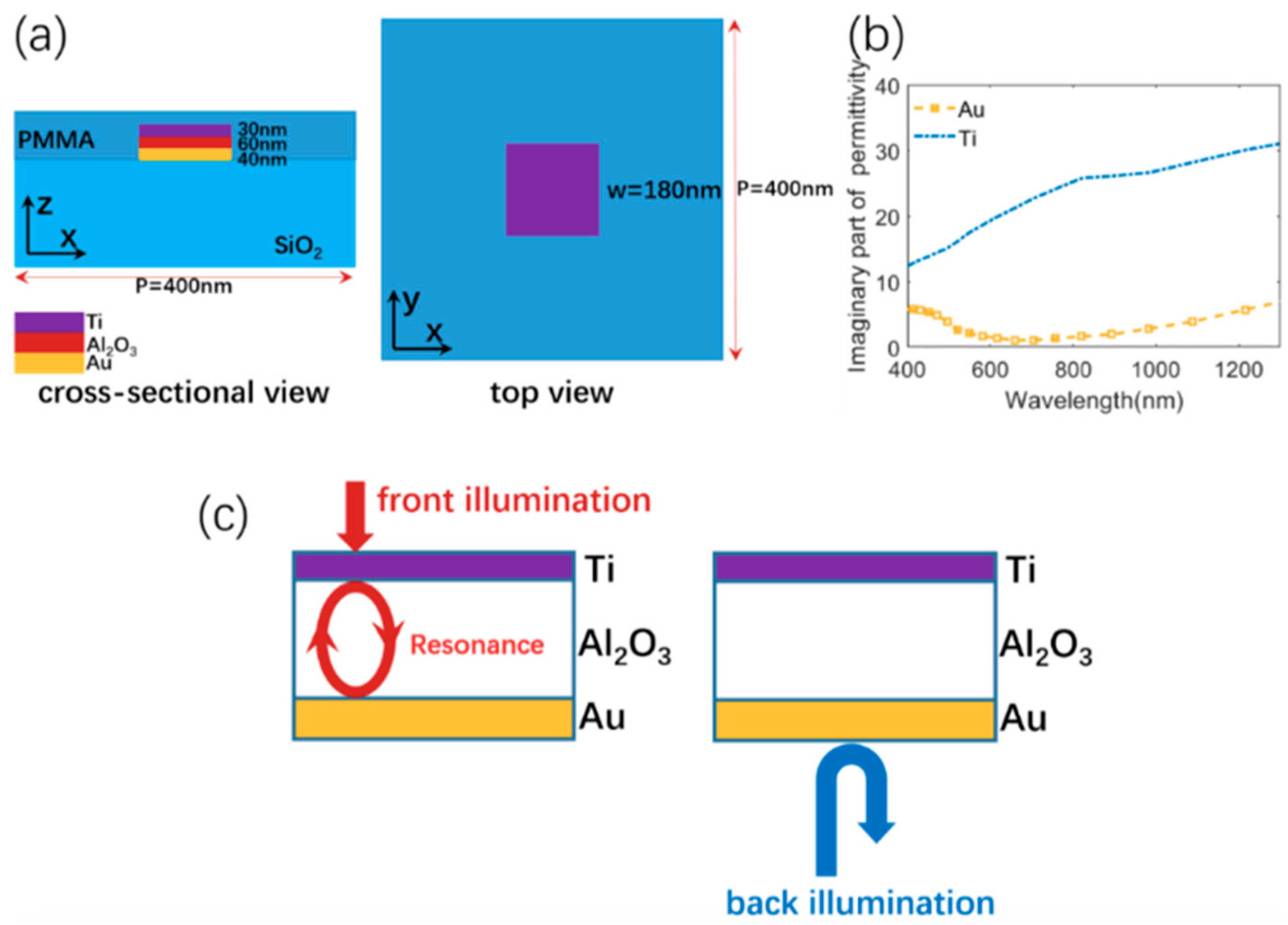
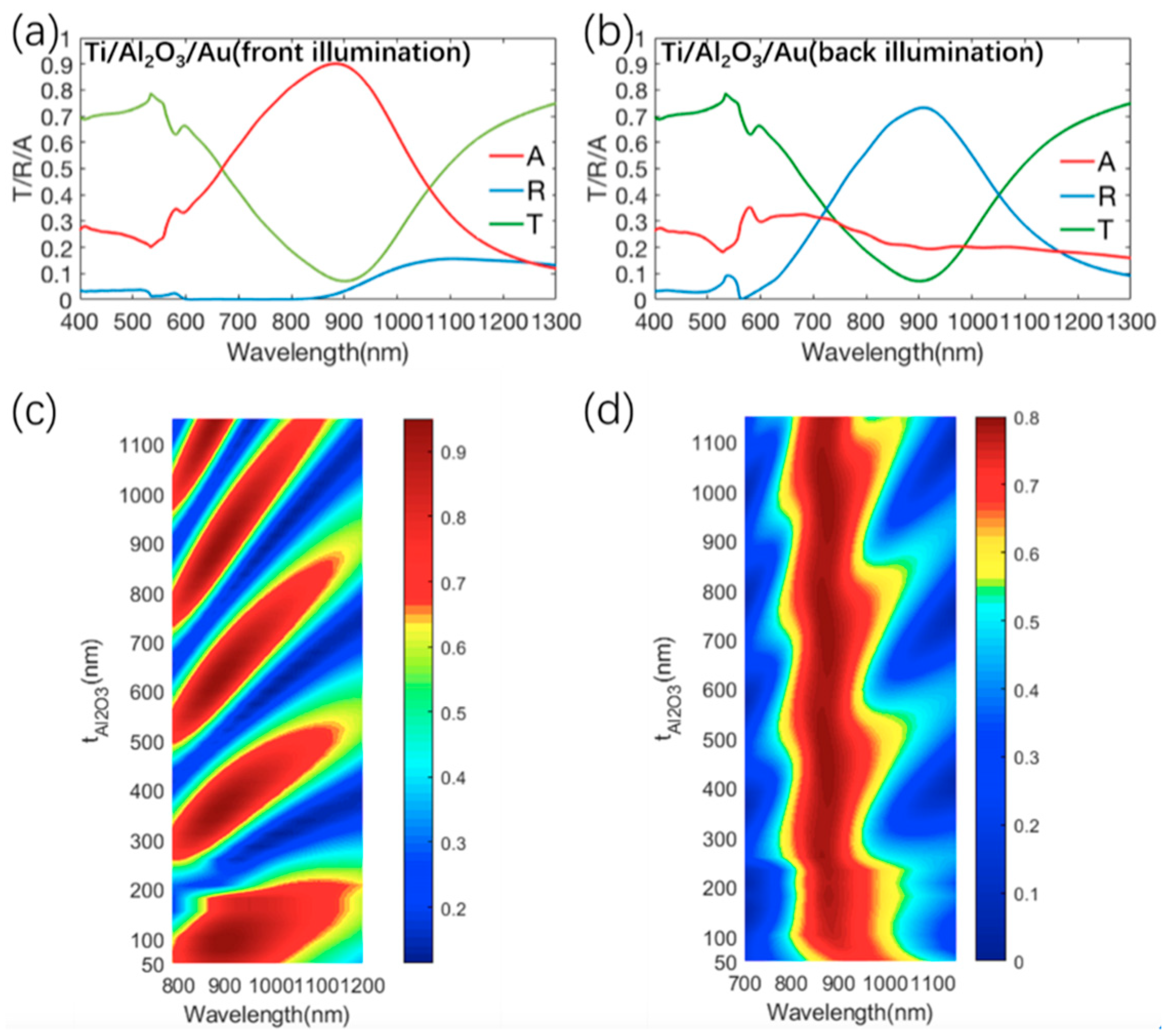
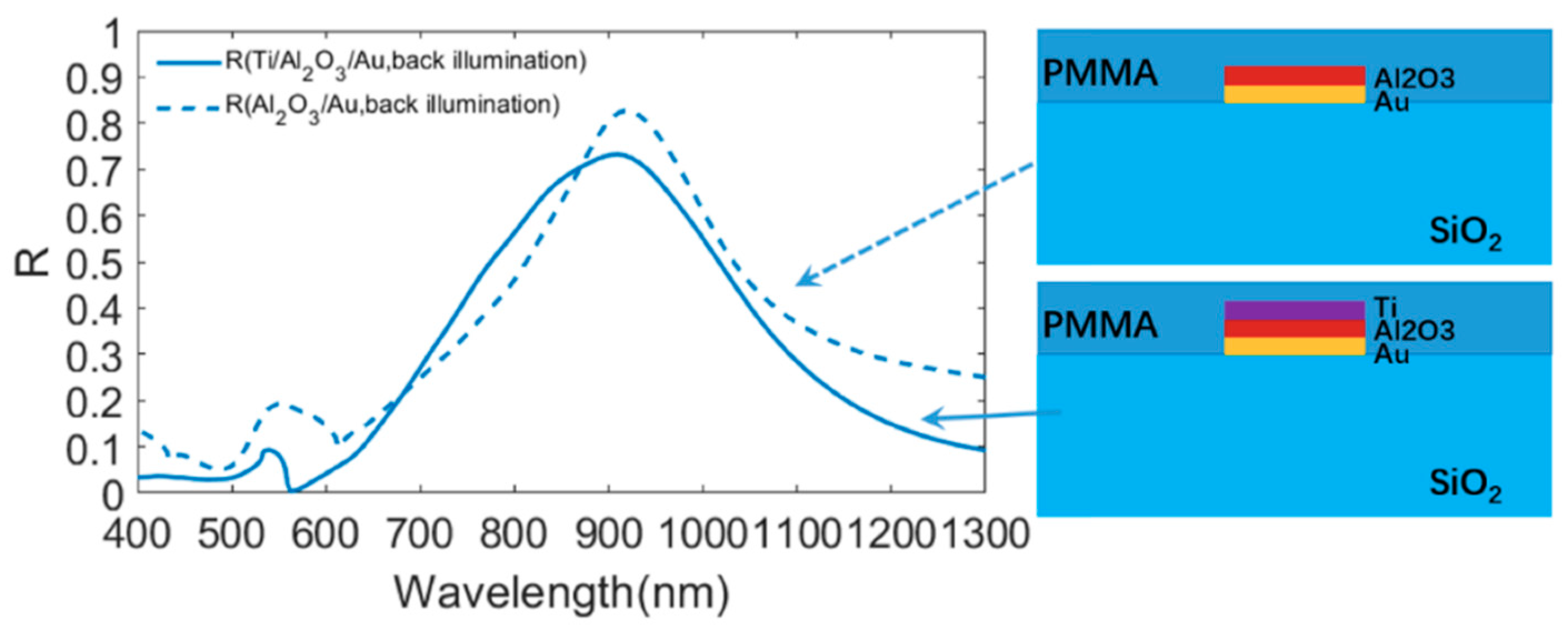



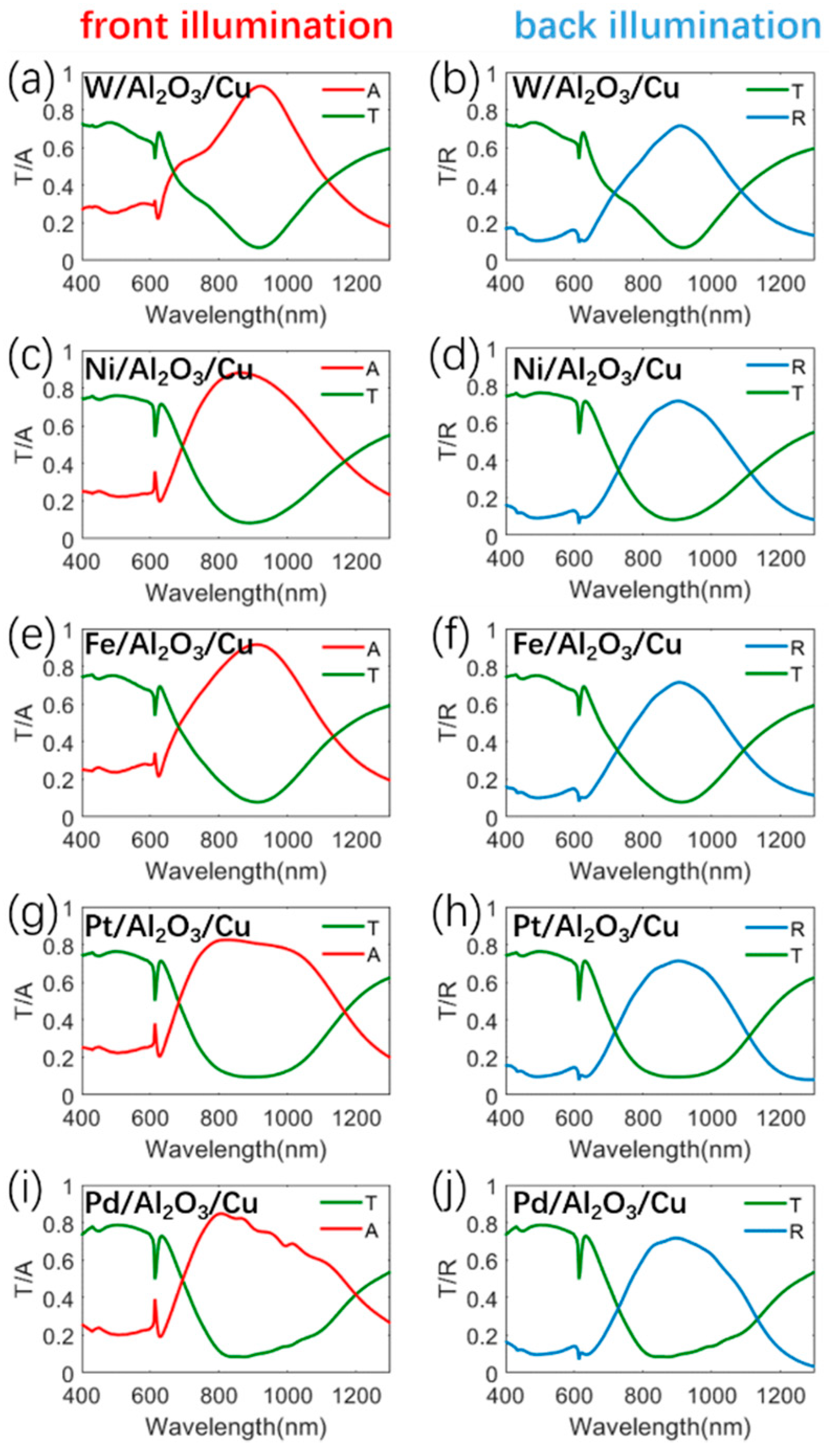
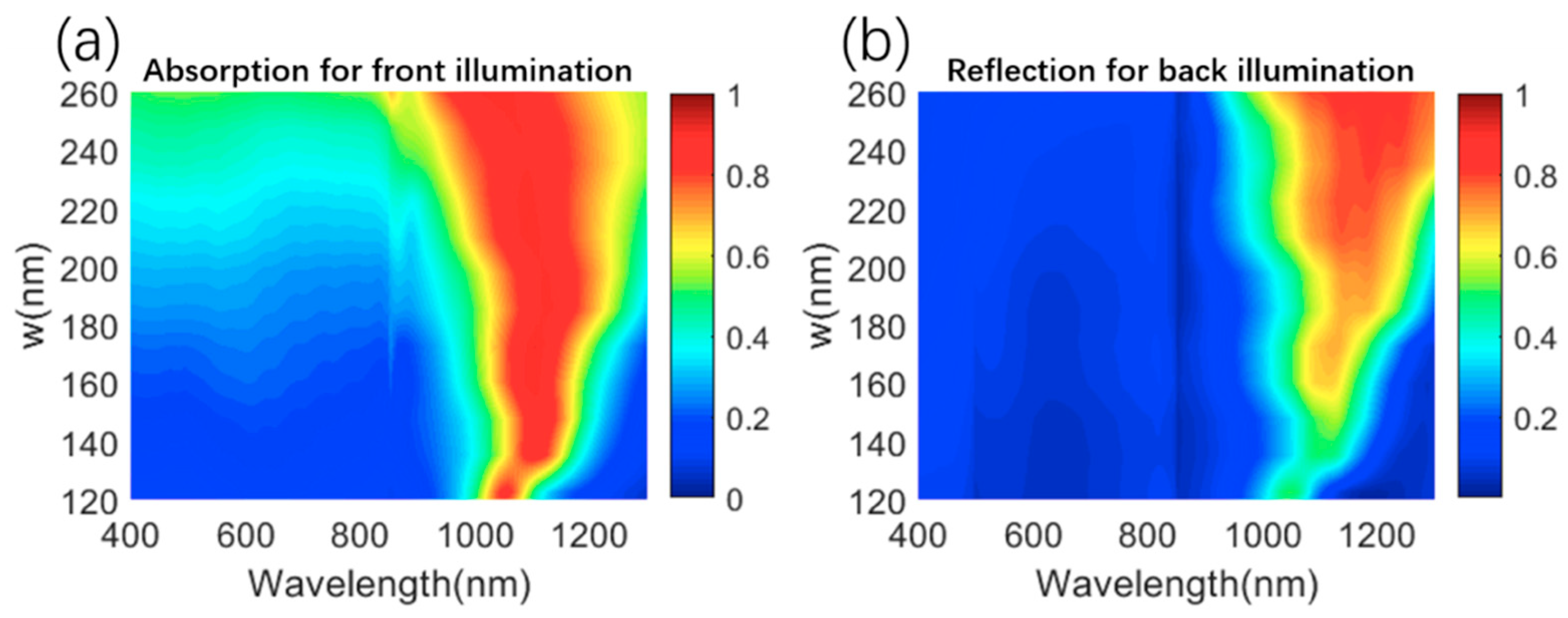
© 2020 by the authors. Licensee MDPI, Basel, Switzerland. This article is an open access article distributed under the terms and conditions of the Creative Commons Attribution (CC BY) license (http://creativecommons.org/licenses/by/4.0/).
Share and Cite
Wu, D.; Meng, Y.; Liu, C. Design of Transparent Metasurfaces Based on Asymmetric Nanostructures for Directional and Selective Absorption. Materials 2020, 13, 3751. https://doi.org/10.3390/ma13173751
Wu D, Meng Y, Liu C. Design of Transparent Metasurfaces Based on Asymmetric Nanostructures for Directional and Selective Absorption. Materials. 2020; 13(17):3751. https://doi.org/10.3390/ma13173751
Chicago/Turabian StyleWu, Dong, Yang Meng, and Chang Liu. 2020. "Design of Transparent Metasurfaces Based on Asymmetric Nanostructures for Directional and Selective Absorption" Materials 13, no. 17: 3751. https://doi.org/10.3390/ma13173751




